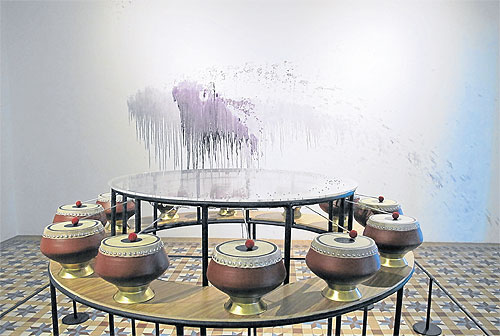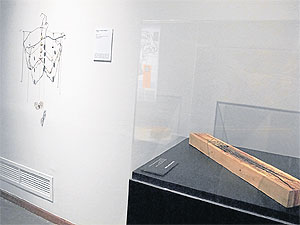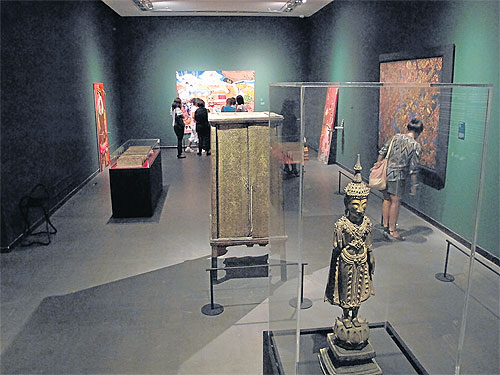Discussing cultural identity
A Thai art exhibition in Singapore explores finding a way forward while preserving the past
Writer: Judha Suwanmongkol
A week before the massive exhibition "Thai Trends" ended at Bangkok Art and Culture Centre, chief curator Prof Apinan Poshyananda moved a few steps away from the Thai capital to the city state of Singapore. He orchestrated "Thai Transience" at Singapore Art Museum, an exhibition that opened on Oct 26 and runs until Jan 6. The showcase is part of the Thai Cultural Festival organised by Singapore's National Heritage Board, which continues until February.
Thai Transience can be seen as a continuation of Thai Trends, yet an abridged version of it. There are 25 Thai artists whose works are featured along with selected Thai historical artefacts. The juxtaposition of Thai contemporary art and Thai craft is risky, since the strategy could be read merely as a collection of ancient relics mixed with modern works, but without any real dialogue _ I mean risky, yet challenging.
Apinan calls the distinction between art and craft, a division propagated by Western art historians, irrelevant. Once again, his view implicitly leads to the question of definitions or identities of "Thainess" _ despite the word "Thai" being in the show's title. Prominent in the group is Rirkrit Tiravanija. The artist, world-famous for cooking at exhibitions, was tipped off by the curator to trace back to the work of Khrua In Khong, a Thai monk painter in the reigns of Rama III and IV. Through it Rirkrit came up with a new work, Freedom Cannot Be Simulated (2012) _ a reminder of the word sign he created for the facade of the Jack Chiles Gallery, New York, in July this year. The white chalk drawing on black walls mocks the style of Khrua In Khong's Ramayana drawing _ thank Lord Buddha, we don't need to eat anything in the museum this time. It is a revisiting of the ancient style without any serious reinterpretation.
On another wall in the same room is a The Raft Of The Medusa-style drawing with the wording: "We don't believe in Thai flood" _ as if an echo of Banksy's graffiti "I don't believe in global warming" on the wall next to Regent's canal in London.
The name comes first _ the name, then the work? Rirkrit's fame has made him a fixture in many group exhibitions representing the Thai art scene. Meanwhile, Apichatpong Weerasehthakul sends his dreamy, ghostly video The Phantom Of Nabua, which depicts a village in the Northeast in a way that's real and hallucinatory.
Then we have Araya Rasdjarmrearnsook's fabulously titled Village And Elsewhere: Artemisia Gentileschi's Judith Beheading Holofernes, Jeff Koons' Untitled And Thai Villagers (2011), a nearly 20-minute video in which Thai villagers are invited to comment on two famous Western artworks mentioned in the title. It is a work of biting humour, which is Araya's signature. All three works are solid on their own, having whole rooms to themselves.
The juxtaposition of the new and the old, as I mentioned before, is a more interesting point. The coloured rooms in Thai Trends did not work very well since a large number of featured works in each room meant it was impossible to find artistic coordination and match-ups. But the attempt seems quite impressive in Thai Transience. Maybe less is better.
The brown-coloured room representing northeastern Thailand's heritage and artists is a good example. Old stone sculptures in the shape of animals, along with Ban Chiang's archaeological pottery, respond visually and contextually to paintings by Thawee Ratchaneekorn, Chokchai Tukpoe, and sculptures by Prasit Wichaya. Works of art alone will never give such a dry and dynamic texture, so old stone figures of toads, crocodiles, and real salt litter the middle of the room to intensify the lively yet rough feeling of the Northeast. Another example is the green room: Traditional Thai paintings, old religious scriptures and Buddha sculptures contrast as well as complement Yuree Kensaku's paintings, which narrate stories about belief and religion in vivacious pop-colour. There's more than one way to discuss Buddhism, obviously.
An ancient manuscript (from the Rattanakosin period, c.1911-1946) tied by many little braids made of hair is intriguing next to Imhathai Suwattanasilp's hair-knitting works _ they're visually compatible. Imhathai's My Father's Pigtail, made from the hair of the artist's father is a mirror of the hair on the manuscript. The artist also shows My Father's Pillow, a coffin-sized bed, and Female Artist, an installation piece also made of knitted hair. The latter represents a kind of female sickness _ altogether, her works give an air of life nearing death, or of death coming to life.
The other female artist, Bussaraporn Thongchai's Me & Mum, You & Me, I Miss You (2012), is a drawing on the wall showing the image of linga matching with a yoni _ a vagina _ stone carving from Mahachai Temple in the Ayutthaya period. The meeting of the two genitalia sounds like a happy ending, yet, I think, it's problematic. A female artist talking about sex doesn't always lead to the concept of feminism _ just like any "ism" in Thailand used without constructive criticism. The portrayal of Bussaraporn's lovers remains in the patriarchal thinking, since it identifies herself by the existence of those men.
A conceptual work that questions the authority of art and its transient (dis)appearance is Pratchaya Phinthong's Untitled (Invisible Ink), which the Thai artist collaborates with a Singaporean assistant. It's just a splatter of colour on a white cube, which represents the institutionalisation of art. No dialogue with any ancient craft, yet it's outstanding and provoking _ art should be somehow disturbing, rather than tame, and this one performs that function.
Thai Transience features a clear curatorial process and has a conceptual strategy that can fail as much as fascinate. It's unfortunate, however, that interesting and debatable Thai art exhibitions sometimes take place far away from Thai borders. This leads us to another question about art policy, how the government values and sponsors contemporary art, and in what condition. Undeniably, some seeds can grow better in a foreign field where art doesn't need to prove its pre-ordained functionality.
Perhaps, this is what Apinan means by mentioning the "soft power of art". Good art politically affects society without the need to declare any rough political statement. Viewed from a different angle but probably born of the same paradigm, this is an attempt to discuss national/cultural identity, the so-called "Thainess". But then again, is it really relevant? The question is ephemeral yet acceptable, but the answer is maybe unnecessary. As the name of the exhibition suggests, it can be implied that there is no such rigid, last-forever definition of ourselves or themselves.
The Thai title of Thai Transience is Thai Lai Ning, which is borrowed from the phrase nam lai ning ("still, flowing water", as translated by revered monk Chah Bhikku), shows what we choose to put close to us, and what is still far away. The juxtaposition of old and new establishments urges us to contemplate new meanings, at least for me, and not to readily believe, but to look outside our own sphere of knowledge. To see and be seen.
Writer: Judha Suwanmongkol
I copy this article from : http://www.bangkokpost.com/arts-and-culture/art/319920/discussing-cultural-identity



ไม่มีความคิดเห็น:
แสดงความคิดเห็น